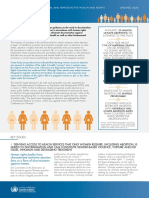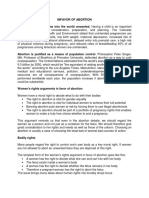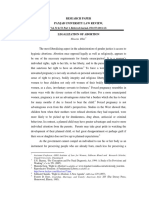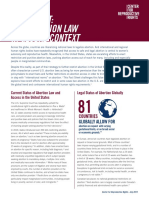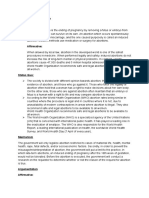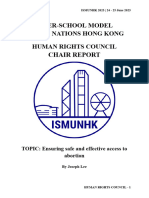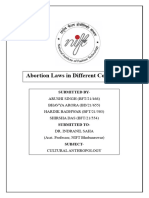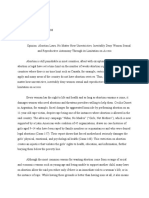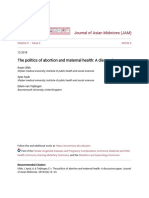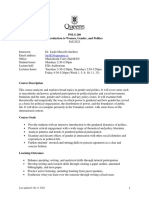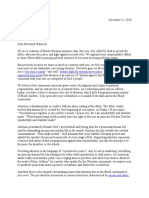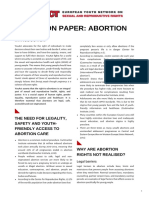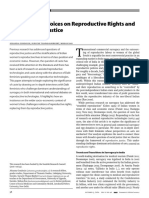Vibgyor Model United Nations 2025 - 15th Edition
(MOCK SESSION)
The United Nations Status Commission On The Status Of Women
1| UNCSW
� BACKGROUND GUIDE
Agendas :
Addressing Social, Legal, and Economic Barriers to Abortion in Advancing
Women's Anatomy and Health
Written by
Krisha Vanjole | Chairperson
Tanvi Kamat | Chairperson
Executive Board Members, UNCSW
Vibgyor MUN 2025
2| UNCSW
� INTRODUCTION TO THE AGENDA
Abortion remains one of the most polarizing and politically sensitive issues of our time, yet it is
fundamentally a matter of pubic health, human rights, and gender equality. The agenda
“Addressing Social, Legal, and Economic Barriers to Abortion in Advancing Women’s
Autonomy and Health” brings to the forefront the urgent need to dismantle the multifaceted
obstacles that prevent individuals, particularly women, from accessing safe, legal, and affordable
abortion services. The conversation around abortion is often reduced to moral or religious
debate, overlooking the fact that it is first and foremost a question of agency: the right of a
person to make decisions about their own body, health, and future.
Globally, millions of women face challenges when seeking abortion care. In many countries,
laws are overly restrictive or entirely prohibitive, criminalizing abortion even in the case of rape,
incest, or threats to the woman’s life. These laws not only endanger physical and mental
well-being but also push countless women into the shadows, where they are forced to resort to
unsafe, unregulated methods. According to the World Health Organization, approximately 45%
of all abortions worldwide are unsafe, with the overwhelming majority occurring in countries
with highly restrictive abortion laws. The consequences are devastating: unsafe abortions are one
of the leading causes of maternal mortality and long-term reproductive health complications.
However, legal restrictions are only one layer of the problem. Social and cultural stigma play a
powerful role in shaping access to abortion. In many societies, abortion is heavily tabooed,
framed as immoral or shameful. Women who seek an abortion often face ostracization,
harassment, or violence not just from the community, but sometimes from their own families.
This stigma silences conversations around reproductive rights, limits access to accurate
information, and fosters a culture of fear and misinformation. Healthcare providers, too, may
refuse to offer services out of fear of backlash or due to personal beliefs, further reducing safe
options for women, even in places where abortion is technically legal.
Economic barriers compound the crisis. Access to abortion is deeply unequal across
socioeconomic lines. In urban areas or private clinics, abortion may be accessible, but for women
in rural or impoverished communities, reaching a facility may be financially and logistically
impossible. The cost of transportation, the procedure itself, potential accommodation, lost wages,
and follow-up care all contribute to making abortion inaccessible for the most vulnerable. Thus,
while wealthy women can often navigate these obstacles with ease, poor women, especially
those from marginalized groups, are left without viable options. This disparity deepens cycles of
poverty and reinforces gender-based inequality.
The denial of abortion is not only a denial of healthcare — it is a denial of freedom. When a
woman is forced to carry an unwanted or dangerous pregnancy, her autonomy, dignity, and future
are compromised. The agenda at hand acknowledges that addressing abortion access is not about
3| UNCSW
�encouraging or discouraging the act itself, but about safeguarding the conditions under which a
woman can make that decision freely, safely, and without fear. It demands a rights-based
approach that recognizes reproductive rights as human rights.
Advancing women’s autonomy and health requires a holistic strategy: legal reform that
decriminalizes and destigmatizes abortion; education that empowers individuals with accurate,
comprehensive knowledge about sexual and reproductive health; investment in public healthcare
systems that ensure access to services regardless of geography or income; and social efforts to
normalize and protect reproductive decision-making. Importantly, solutions must be
intersectional, accounting for the specific needs of adolescents, LGBTQ+ individuals, people
with disabilities, and ethnic minorities, all of whom face compounded barriers.
In an era that continues to grapple with gender inequality and healthcare disparities, the global
community must confront abortion not as a controversial exception but as an essential part of
human dignity and healthcare justice. By addressing the social, legal, and economic barriers to
abortion, we take a necessary step toward creating a world in which all people, regardless of
background or circumstance, have the right and ability to make informed decisions about their
bodies and lives.
4| UNCSW
� KEY TERMINOLOGIES
Understanding the foundational terms surrounding the abortion rights discourse is essential for
all delegates engaging with this agenda. The following definitions will help provide clarity and
context in debates, resolutions, and policy recommendations:
1. Abortion
The intentional termination of a pregnancy by removing or expelling an embryo or fetus before it
becomes viable (typically before 24 weeks of gestation, though this varies by jurisdiction).
2. Safe Abortion
A medically approved procedure performed by a qualified health professional using techniques
recommended by the World Health Organization (WHO), under hygienic and controlled
conditions that ensure minimal risk to the individual.
3. Unsafe Abortion
A procedure to end an unintended pregnancy either by individuals without proper training or in
environments that do not meet minimal medical standards. Unsafe abortions are a leading cause
of maternal morbidity and mortality, especially in restrictive legal settings.
4. Medical Abortion
Also called medication abortion, this involves using pharmaceutical drugs — most commonly
mifepristone and misoprostol — to terminate early pregnancies (usually within the first 10–12
weeks). It is non-invasive and increasingly used in telehealth services.
5. Surgical Abortion
A clinical procedure to end a pregnancy by removing the fetus or embryo from the uterus.
Common methods include manual vacuum aspiration (MVA) and dilation and curettage (D&C).
6. Reproductive Rights
The legal rights and freedoms relating to reproduction and reproductive health, including access
to contraception, abortion services, fertility treatment, and maternal health care. These rights are
grounded in broader frameworks of gender equality and human dignity.
5| UNCSW
�7. Reproductive Justice
A framework that goes beyond individual choice, linking reproductive rights with social justice.
Coined by women of color, this term emphasizes how race, class, gender, and other identities
intersect to impact reproductive autonomy and access.
8. Bodily Autonomy
The right of every person to govern what happens to their body without external control or
coercion. In this context, it refers to the right to make informed decisions about pregnancy and
reproductive health.
9. Maternal Mortality Rate (MMR)
The number of women who die due to complications related to pregnancy or childbirth per
100,000 live births. Unsafe abortion is a significant contributor to high MMR in many
developing countries.
10. Conscientious Objection
A legal provision allowing healthcare providers to refuse to perform abortions on the basis of
personal, religious, or moral beliefs. While recognized in some countries, it often becomes a
barrier when not adequately regulated.
11. Criminalization of Abortion
The legal classification of abortion as a crime punishable by law, either for the person seeking
the abortion, the provider, or both. This often pushes abortion underground and leads to unsafe
practices.
12. Decriminalization of Abortion
The removal of criminal penalties associated with abortion. It does not necessarily make abortion
freely accessible, but removes it from the criminal justice system.
13. Parental Consent Laws
Laws that require minors to obtain parental or guardian permission before receiving an abortion.
These are common in conservative legal systems and often deter adolescents from seeking safe
care.
6| UNCSW
�14. Gestational Limits
Legal thresholds (measured in weeks) after which abortion may be restricted or prohibited unless
specific conditions are met (e.g., risk to the mother’s life). These vary across jurisdictions.
15. Telemedicine Abortion
A process through which individuals consult healthcare professionals remotely (e.g., via video or
phone) and receive abortion pills by mail. This method has expanded access, particularly in
regions with restrictive or remote conditions.
7| UNCSW
� HISTORICAL & LEGAL EVALUATION OF ABORTION RIGHTS
The history of abortion rights is long, complex, and heavily influenced by cultural, religious,
medical, and political developments. In ancient civilizations such as Greece, Rome, China, and
Egypt, abortion was a relatively accepted practice. Early methods included herbal remedies,
physical techniques, or traditional interventions, and were generally unregulated. There was little
legal interference, particularly in the early stages of pregnancy. These early societies often
viewed abortion as a pragmatic decision based on factors like economic burden, family size, or
social norms. However, as major organized religions like Christianity and Islam emerged, views
began to shift. In medieval Europe, for instance, abortion was increasingly condemned,
particularly after "quickening," the first noticeable fetal movements, which was seen as the
moment the soul entered the body. Religious teachings gradually shaped public morality and
began influencing abortion-related laws.
The colonial era further entrenched restrictive abortion policies. European powers imposed
criminal laws on their colonies, many of which are still in effect today. In the 19th century, many
countries in Europe and North America began to criminalize abortion almost entirely, often
under the guise of protecting maternal health or asserting male-dominated medical authority.
These laws were less about preserving fetal life and more about controlling women’s bodies and
reproductive autonomy. At the same time, scientific advances in anatomy and obstetrics
ironically gave rise to more regulation rather than liberalization. Physicians began replacing
midwives, and medical institutions pushed for stricter abortion bans under the pretense of
safeguarding professional standards.
The 20th century witnessed a dramatic shift, particularly with the rise of feminist movements. As
women demanded the right to vote, work, and access education, reproductive freedom became a
central theme in the fight for gender equality. Across the world, activists and public health
experts began challenging the harmful effects of illegal abortions, especially maternal deaths
caused by unsafe procedures. Countries gradually began reforming their abortion laws. The
Soviet Union became the first to legalize abortion in 1920. The United Kingdom passed the
Abortion Act in 1967, allowing the procedure under specific medical conditions. One of the most
transformative legal decisions came in 1973 with the U.S. Supreme Court ruling in Roe v. Wade,
which established the constitutional right to abortion under the right to privacy. This judgment
influenced global advocacy efforts for decades, until it was overturned in 2022 by Dobbs v.
Jackson Women’s Health Organization, returning abortion regulation to individual states and
sparking a fresh wave of political and legal battles.
In many developing countries, reforms also began to take shape. India enacted the Medical
Termination of Pregnancy (MTP) Act in 1971, legalizing abortion under broad conditions like
risk to the mother’s life, contraceptive failure, and fetal abnormalities. South Africa, Nepal, and
8| UNCSW
�Vietnam followed with similarly progressive laws. The 1994 International Conference on
Population and Development (ICPD) in Cairo further recognized reproductive rights as integral
to human rights, calling on governments to ensure access to safe and legal abortion where
permitted by law. This conference helped reframe abortion not just as a health issue, but as a
matter of autonomy, dignity, and equality.
Despite this progress, the 21st century has witnessed both advances and setbacks. While
countries like Ireland, Argentina, and Mexico have recently liberalized abortion laws through
referenda and constitutional reforms, others, such as Poland, the United States (post-Dobbs), and
several African and Middle Eastern states, have doubled down on restrictions, often under
political or religious pressure. Today, abortion rights remain a legal battleground, with access
varying dramatically across borders. The historical and legal evolution of abortion is a testament
to how deeply personal health decisions are shaped by broader social forces — and how legal
reform, public education, and activism remain essential tools in securing reproductive justice.
9| UNCSW
� SOCIAL, CULTURAL, & RELIGIOUS BARRIERS TO ACCESS
Social, cultural, and religious barriers are among the most deeply entrenched obstacles to
abortion access, often more powerful and persistent than legal restrictions themselves. In many
societies, abortion is viewed not as a healthcare right but as a moral failing, often linked to
notions of shame, dishonor, or sin. Women who seek abortions may face severe social stigma,
including isolation, harassment, or even violence from their families or communities. This
stigma discourages open dialogue about reproductive health and compels many women to seek
unsafe, underground procedures to avoid public scrutiny. The social pressure to conform to
traditional roles — especially those that emphasize motherhood as a woman’s primary duty —
reinforces gender inequality and erodes support for abortion rights.
Cultural norms and traditions often uphold patriarchal values that prioritize family honor, marital
status, and fertility over a woman’s agency. In some communities, the idea of a woman
voluntarily ending a pregnancy is seen as rebellion against cultural expectations or religious
doctrines. Unmarried women, adolescent girls, and survivors of sexual violence are especially
vulnerable to this scrutiny. The fear of being labeled “immoral” or “irresponsible” often prevents
them from seeking timely and safe abortion services. Moreover, in regions where comprehensive
sex education is lacking, myths and misinformation about abortion abound, such as the belief
that it causes infertility, cancer, or mental illness, further discouraging women from accessing
care.
Religious opposition also plays a significant role in shaping public attitudes and national
policies. In many countries, religious leaders wield considerable influence over political
decisions, especially concerning reproductive rights. The Catholic Church, for instance,
maintains a firm anti-abortion stance and has influenced legislation in Latin America, the
Philippines, and parts of Europe. Islamic teachings on abortion vary by interpretation and school
of thought, but often restrict the procedure after a certain gestational age unless the mother’s life
is at risk. In Hindu-majority regions, traditional beliefs about karma and motherhood can
discourage abortion, even if not explicitly prohibited. Evangelical Christian groups, particularly
in the United States and sub-Saharan Africa, have been active in promoting anti-abortion
legislation and campaigns that reinforce stigma.
Media portrayals further compound these barriers. Abortion is often dramatized in films and
television as traumatic, rare, or morally wrong, rather than being depicted as a safe, routine
medical procedure. This misrepresentation distorts public understanding and fuels fear,
especially among young people. Meanwhile, in conservative societies, public figures and
institutions often avoid speaking about abortion altogether, treating it as taboo rather than a
public health issue. As a result, silence, fear, and misinformation dominate the public discourse.
10| UNCSW
�Overcoming social, cultural, and religious barriers requires more than just changing laws. It
demands comprehensive strategies that include public education, community-based awareness
programs, engagement with religious and cultural leaders, and platforms for open, stigma-free
conversations. Empowering women to speak about their experiences, normalizing reproductive
health discussions, and promoting inclusive sex education are all critical steps. Only by
addressing these deep-rooted social dynamics can societies begin to build safe, supportive
environments where abortion care is seen not as a scandal, but as a basic and essential human
right.
11| UNCSW
� LEGAL & CONSTITUTIONAL BARRIERS ACROSS NATIONS
The legal framework governing abortion varies drastically across countries, reflecting
deep-rooted historical, cultural, religious, and political influences. In some nations, abortion is
completely banned or permitted only under extremely limited circumstances, such as to save the
life of the pregnant woman. For instance, countries like El Salvador and the Philippines maintain
near-total prohibitions on abortion, criminalizing the practice even in cases of rape or serious
health risks. Other countries adopt a more conditional approach, allowing abortion under specific
situations such as rape, incest, fetal abnormalities, or threats to the mother’s physical or mental
health. These conditions, however, often come with restrictive qualifications or bureaucratic
hurdles that limit effective access.
Legal restrictions also commonly include gestational limits, which cap the permissible period
during pregnancy when abortion can be legally sought. Many European countries allow abortion
up to 12 to 24 weeks, with exceptions granted afterward only in rare cases. Additional legal
barriers may involve mandatory waiting periods, compulsory counseling, or requirements for
parental or spousal consent, which disproportionately affect minors and married women,
undermining their bodily autonomy and access to timely care. Such laws often create significant
delays and increase the emotional and logistical burden on those seeking abortions.
Constitutions and judicial systems further shape abortion rights through their interpretations of
fundamental rights. Some constitutions explicitly protect the right to life from conception, which
has been used to justify restrictive abortion laws. Conversely, other constitutions enshrine rights
to privacy, health, and bodily autonomy, providing a legal basis for abortion access. Courts have
played a crucial role in either expanding or limiting abortion rights via landmark rulings. For
example, the U.S. Supreme Court’s Roe v. Wade decision (recently overturned) historically
established a constitutional right to abortion, while countries like Ireland have recently
liberalized their laws through popular referendums and judicial decisions.
Criminalization remains a significant barrier in many regions, with both providers and women
facing imprisonment, fines, or other penalties. This punitive approach pushes abortion
underground, leading to unsafe procedures that contribute to high rates of maternal morbidity
and mortality. Fear of legal repercussions also discourages healthcare professionals from offering
abortion services or even information, further restricting access. Overall, legal and constitutional
barriers create a fragmented global landscape where access to abortion depends heavily on
national laws and judicial attitudes, often at the expense of women’s health and rights.
12| UNCSW
� ECONOMIC INEQUALITIES & INFRASTRUCTURAL CHALLENGES
Economic disparities play a crucial role in shaping access to abortion services worldwide. In
many low- and middle-income countries, the cost of safe abortion procedures, related medical
care, and travel to healthcare facilities can be prohibitively expensive for large segments of the
population. Women from economically disadvantaged backgrounds often face significant
financial barriers, forcing them to either delay care, seek unsafe alternatives, or forgo abortion
services altogether. Even in wealthier nations, marginalized groups such as low-income women,
rural populations, and ethnic minorities frequently encounter systemic economic obstacles that
limit their reproductive choices.
Infrastructural challenges compound these economic inequalities. In many regions, especially
rural or underserved areas, healthcare infrastructure is inadequate or unevenly distributed.
Clinics and hospitals providing abortion services may be scarce, poorly equipped, or staffed by
providers unwilling or untrained to perform abortions due to legal, cultural, or personal reasons.
This lack of accessible and quality healthcare facilities forces women to travel long distances,
often at great expense and risk, to obtain safe abortions. The absence of reliable public
transportation, limited financial resources, and restrictive laws around clinic locations further
exacerbate these difficulties.
Moreover, economic inequalities intersect with other social determinants such as education,
gender norms, and legal restrictions, deepening barriers to care. Women with fewer resources
often have less access to accurate information about reproductive health and their rights, making
it harder to navigate complex healthcare and legal systems. Additionally, when abortion services
are excluded from public health coverage or insurance plans, the out-of-pocket expenses
disproportionately affect vulnerable populations. Addressing these economic and infrastructural
challenges is essential for ensuring equitable access to safe abortion and advancing women’s
autonomy and health on a global scale.
13| UNCSW
� HEALTH IMPACTS: PHYSICAL, MENTAL, & REPRODUCTIVE OUTCOMES
The health consequences of restricted or unsafe abortion access are profound and multifaceted,
affecting women’s physical, mental, and reproductive well-being. Physically, unsafe
abortions—often resulting from legal restrictions, economic barriers, or lack of access to trained
providers—are a leading cause of maternal morbidity and mortality worldwide. Complications
from unsafe procedures can include severe bleeding, infections, injury to internal organs, and
infertility. According to the World Health Organization, unsafe abortions account for a
significant proportion of preventable maternal deaths, particularly in low- and middle-income
countries where legal and infrastructural barriers are more pronounced.
Beyond physical health, restricted access to abortion can severely impact mental health. Women
forced to carry unwanted pregnancies to term often experience increased rates of depression,
anxiety, and psychological distress. The stigma associated with abortion and fear of legal
consequences can compound these mental health challenges. Conversely, having access to safe
and legal abortion services has been shown to improve psychological outcomes, as it supports
women’s autonomy and control over their reproductive choices.
Reproductive health outcomes are also deeply influenced by abortion access. Women denied
timely abortion care may face risks of complicated pregnancies, unsafe childbirth, and adverse
neonatal outcomes. Additionally, unsafe abortions can lead to long-term reproductive
complications such as infertility or chronic pelvic pain. Ensuring comprehensive reproductive
healthcare, including access to safe abortion, contraception, and post-abortion care, is critical to
safeguarding women’s overall health. Addressing these health impacts requires integrated
policies that prioritize safe abortion access, eliminate stigma, and provide holistic support to
women’s physical and mental well-being.
14| UNCSW
� YOUTH, MARGINALIZED GROUPS & INTERSECTIONAL BARRIERS
Access to safe and legal abortion is often significantly more challenging for youth and
marginalized groups due to intersecting social, economic, and legal barriers. Young people,
particularly adolescents, face unique obstacles including restrictive parental consent laws, lack of
confidential services, and limited access to accurate sexual and reproductive health education.
These factors contribute to delays or denial of abortion care, increasing the risk of unsafe
procedures and adverse health outcomes. Additionally, societal stigma around youth sexuality
often discourages young women from seeking information or services openly.
Marginalized groups—including ethnic minorities, LGBTQ+ individuals, refugees, migrants, and
those living in poverty—face compounded difficulties in accessing abortion. Discrimination and
systemic inequities in healthcare provision often mean these groups encounter prejudice,
language barriers, and cultural insensitivity within medical systems. For example, indigenous
women or racial minorities in various countries experience disproportionately higher rates of
maternal mortality linked to restricted reproductive healthcare access. Migrants and refugees
may lack legal documentation or face fear of deportation, deterring them from seeking care.
Intersectionality—the overlapping and interacting nature of social identities such as gender, race,
class, and age—amplifies these barriers. For instance, a young, low-income, ethnic minority
woman may confront multiple layers of disadvantage that collectively restrict her access to
abortion services far beyond any single factor. Recognizing and addressing these intersectional
challenges is essential to formulating inclusive policies that ensure reproductive justice for all,
rather than a privileged few. Tailored interventions, culturally sensitive healthcare, and legal
reforms are needed to dismantle these overlapping barriers and promote equitable access to
abortion care.
15| UNCSW
� ROLE OF MEDIA, TECHNOLOGY, & MISINFORMATION
Media and technology play a pivotal role in shaping public perception, knowledge, and access to
abortion services. On one hand, digital platforms, social media, and telemedicine have expanded
access to reproductive health information and services, especially in regions where abortion is
heavily restricted. Telehealth services, for example, allow women to safely obtain medical
abortion pills and receive guidance remotely, breaking down geographic and social barriers.
Social media campaigns and online communities can also empower women by providing
support, sharing personal stories, and advocating for reproductive rights.
However, the same channels can also be sources of widespread misinformation and stigma.
Anti-abortion groups often exploit social media to disseminate false or misleading information
about the safety, legality, and morality of abortion, contributing to confusion and fear among the
public. This misinformation can lead to harmful myths, discourage women from seeking safe
care, and reinforce negative stereotypes. Additionally, digital censorship, algorithm biases, and
restrictions imposed by governments or platforms may limit the visibility of accurate
abortion-related content, further complicating access to reliable information.
Traditional media—television, newspapers, and radio—also influence public opinion and
policymaking. Sensationalized or biased reporting can deepen social stigma, whereas responsible
journalism can educate audiences and highlight the human rights aspects of abortion. Overall,
while media and technology hold great potential as tools for advancing women’s autonomy and
health, they must be navigated carefully to counteract misinformation and ensure equitable
access to factual, non-judgmental reproductive health resources.
16| UNCSW
� INTERNATIONAL FRAMEWORKS, UN ACTION, & BLOC POSITIONS
International legal frameworks and multilateral institutions play a critical role in shaping global
norms around abortion access, women’s reproductive rights, and health. While abortion laws
remain primarily under national jurisdiction, international human rights bodies and United
Nations (UN) agencies have increasingly recognized access to safe and legal abortion as integral
to fulfilling fundamental human rights such as the right to health, life, privacy, and freedom from
discrimination. These frameworks provide normative guidance and pressure governments to
align their policies with international standards.
Key international instruments, such as the International Covenant on Civil and Political
Rights (ICCPR) and the International Covenant on Economic, Social and Cultural Rights
(ICESCR), underscore rights to life, health, and non-discrimination, which UN treaty bodies
interpret as encompassing access to sexual and reproductive health services, including abortion.
The Convention on the Elimination of All Forms of Discrimination Against Women
(CEDAW) explicitly addresses discrimination in reproductive healthcare and urges states to
eliminate barriers to services. Moreover, the Committee on the Rights of the Child has
emphasized adolescents' rights to confidential and non-discriminatory sexual and reproductive
health care.
The World Health Organization (WHO) provides evidence-based guidelines on safe abortion,
framing it as a critical component of comprehensive reproductive health care. WHO advocates
for the decriminalization of abortion and supports access to safe procedures as essential to
reducing maternal mortality and morbidity. UN human rights mechanisms, including special
rapporteurs on health and violence against women, have called on states to remove punitive laws
and policies that obstruct access.
UN conferences and summits, such as the International Conference on Population and
Development (ICPD) 1994 and the Beijing Platform for Action (1995), have been
instrumental in placing reproductive rights and safe abortion access on the international agenda.
These global agreements stress the importance of empowering women to make autonomous
decisions about their reproductive lives. They also advocate for the integration of safe abortion
services within broader sexual and reproductive health programs.
Despite these international efforts, political divides among regional and ideological blocs
influence the implementation and interpretation of abortion rights. Countries aligned with
Western liberal democracies generally support expanded access to safe and legal abortion as a
matter of human rights and public health. Many European Union nations, Canada, Australia, and
parts of Latin America have progressively liberalized their abortion laws in recent years,
emphasizing women's autonomy.
17| UNCSW
�In contrast, the Group of 77 (G77) and many countries in Africa, the Middle East, and parts of
Asia often adopt more conservative positions. These nations may prioritize cultural, religious, or
traditional values and advocate for restrictions on abortion, sometimes framing it as a moral or
pro-life issue. Some of these states have actively resisted inclusion of abortion language in UN
resolutions and declarations or have pushed for “protecting the unborn child” in international
fora. For example, the influence of the Holy See and other religious actors remains significant in
shaping global debates.
Regional organizations also vary in their approaches. The African Union has shown growing
interest in addressing unsafe abortion as a public health crisis, exemplified by the Maputo
Protocol, which explicitly recognizes women’s reproductive rights including access to abortion
in cases of sexual assault, rape, incest, and when the pregnancy endangers the woman’s life.
Meanwhile, the Organization of Islamic Cooperation (OIC) tends to uphold more restrictive
interpretations consistent with Islamic teachings.
In summary, while international frameworks and UN bodies advocate for abortion access as a
human right and public health necessity, geopolitical, cultural, and religious fault lines create
complex dynamics that influence policy and progress at the national level. Understanding these
diverse bloc positions is crucial for effective diplomacy, advocacy, and the crafting of inclusive
resolutions that can build consensus while advancing women's reproductive autonomy globally.
18| UNCSW
� POLICY RECOMMENDATIONS, CRISIS RESPONSE, & RESOLUTION STRATEGY
Addressing the complex social, legal, and economic barriers to abortion requires comprehensive,
multi-layered policy approaches that prioritize women’s autonomy, health, and human rights.
Effective policy recommendations must be evidence-based, rights-centered, and sensitive to
cultural and contextual realities while challenging harmful norms and practices.
Policy Recommendations begin with the decriminalization of abortion to remove punitive legal
frameworks that criminalize women and healthcare providers. Laws should be reformed to
ensure abortion is safe, legal, and accessible, at minimum in cases of risk to life or health, rape,
incest, and fetal anomalies, with the goal of expanding access beyond restrictive exceptions.
States should eliminate mandatory waiting periods, parental or spousal consent requirements,
and other bureaucratic hurdles that delay or prevent timely access to abortion services.
Incorporating abortion within national healthcare systems as an essential health service, covered
by public insurance or subsidies, is critical to removing financial barriers, particularly for
marginalized and low-income populations.
Health systems strengthening is another key recommendation. Governments should invest in
expanding and improving reproductive health infrastructure, especially in rural and underserved
areas, by training and deploying skilled healthcare providers and ensuring availability of medical
abortion supplies and equipment. Integrating comprehensive sexuality education in schools
equips young people with accurate knowledge, reducing unintended pregnancies and
empowering informed decision-making. Additionally, policies must include robust post-abortion
care and mental health support, recognizing the holistic needs of women.
Addressing social and cultural barriers requires policies aimed at stigma reduction through
public education campaigns that promote gender equality, women’s rights, and reproductive
justice. Governments and civil society should collaborate to engage community leaders, religious
actors, and media to foster supportive environments. Legal protections against harassment or
violence targeting abortion seekers and providers are essential to create safe access.
Crisis response strategies are vital during emergencies, conflicts, or humanitarian crises where
access to sexual and reproductive health services, including abortion, is often disrupted.
International guidelines such as the Minimum Initial Service Package (MISP) for reproductive
health in crisis settings emphasize the urgent need to maintain abortion care as part of essential
health services. Humanitarian actors must be equipped and mandated to provide safe abortion
and post-abortion care even in resource-constrained settings. Governments and international
agencies should establish contingency plans to ensure supply chains for medical abortion drugs
remain uninterrupted.
19| UNCSW
�From a diplomatic and policy-making perspective, resolution strategies within multilateral
forums should emphasize consensus-building that balances respect for cultural diversity with
advancing human rights. Resolutions should call for the removal of discriminatory laws and
barriers while promoting evidence-based practices and rights-based approaches to reproductive
health. Delegates can advocate for increased funding and technical support for health system
strengthening, sexuality education, and community engagement programs.
Strategic alliances among member states, civil society, and international organizations can
amplify advocacy efforts and create momentum for progressive reforms. Monitoring and
accountability mechanisms are critical to track the implementation of commitments and expose
violations of reproductive rights. Data collection and research should be supported to inform
ongoing policy refinement and to highlight disparities in access.
In summary, a successful policy and resolution strategy to overcome abortion barriers must
integrate legal reform, health system investment, social norm change, crisis preparedness, and
robust international cooperation. By centering women’s autonomy and health, these approaches
aim not only to reduce unsafe abortions but also to promote gender equality and human dignity
globally.
20| UNCSW







